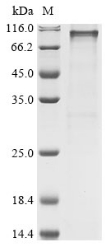Recombinant Human 2-5A-dependent ribonuclease (RNASEL)
CAT:
399-CSB-EP313223HUe0-03
Size:
20 µg
Price:
Ask
- Availability: 24/48H Stock Items & 2 to 6 Weeks non Stock Items.
- Dry Ice Shipment: No




Recombinant Human 2-5A-dependent ribonuclease (RNASEL)
- CAS Number: 9000-83-3
- Gene Name: RNASEL
- UniProt: Q05823
- Expression Region: 1-741aa
- Organism: Homo sapiens
- Target Sequence: MESRDHNNPQEGPTSSSGRRAAVEDNHLLIKAVQNEDVDLVQQLLEGGANVNFQEEEGGWTPLHNAVQMSREDIVELLLRHGADPVLRKKNGATPFILAAIAGSVKLLKLFLSKGADVNECDFYGFTAFMEAAVYGKVKALKFLYKRGANVNLRRKTKEDQERLRKGGATALMDAAEKGHVEVLKILLDEMGADVNACDNMGRNALIHALLSSDDSDVEAITHLLLDHGADVNVRGERGKTPLILAVEKKHLGLVQRLLEQEHIEINDTDSDGKTALLLAVELKLKKIAELLCKRGASTDCGDLVMTARRNYDHSLVKVLLSHGAKEDFHPPAEDWKPQSSHWGAALKDLHRIYRPMIGKLKFFIDEKYKIADTSEGGIYLGFYEKQEVAVKTFCEGSPRAQREVSCLQSSRENSHLVTFYGSESHRGHLFVCVTLCEQTLEACLDVHRGEDVENEEDEFARNVLSSIFKAVQELHLSCGYTHQDLQPQNILIDSKKAAHLADFDKSIKWAGDPQEVKRDLEDLGRLVLYVVKKGSISFEDLKAQSNEEVVQLSPDEETKDLIHRLFHPGEHVRDCLSDLLGHPFFWTWESRYRTLRNVGNESDIKTRKSESEILRLLQPGPSEHSKSFDKWTTKINECVMKKMNKFYEKRGNFYQNTVGDLLKFIRNLGEHIDEEKHKKMKLKIGDPSLYFQKTFPDLVIYVYTKLQNTEYRKHFPQTHSPNKPQCDGAGGASGLASPGC
- Tag: N-terminal GST-tagged
- Source: E.coli
- Field of Research: Epigenetics and Nuclear Signaling
- Assay Type: In Stock Protein
- Relevance: Endoribonuclease that functions in the interferon (IFN) antiviral response. In INF treated and virus infected cells, RNASEL probably mediates its antiviral effects through a combination of direct cleavage of single-stranded viral RNAs, inhibition of protein synthesis through the degradation of rRNA, induction of apoptosis, and induction of other antiviral genes. RNASEL mediated apoptosis is the result of a JNK-dependent stress-response pathway leading to cytochrome c release from mitochondria and caspase-dependent apoptosis. Therefore, activation of RNASEL could lead to elimination of virus infected cells under some circumstances. In the crosstalk between autophagy and apoptosis proposed to induce autophagy as an early stress response to small double-stranded RNA and at later stages of prolonged stress to activate caspase-dependent proteolytic cleavage of BECN1 to terminate autophagy and promote apoptosis (PubMed:26263979). Might play a central role in the regulation of mRNA turnover (PubMed:11585831). Cleaves 3' of UpNp dimers, with preference for UU and UA sequences, to sets of discrete products ranging from between 4 and 22 nucleotides in length.
- Purity: Greater than 85% as determined by SDS-PAGE.
- Activity: Not Test
- Length: Full Length
- Form: Liquid or Lyophilized powder
- Buffer: If the delivery form is liquid, the default storage buffer is Tris/PBS-based buffer, 5%-50% glycerol. If the delivery form is lyophilized powder, the buffer before lyophilization is Tris/PBS-based buffer, 6% Trehalose, pH 8.0.
- Reconstitution: We recommend that this vial be briefly centrifuged prior to opening to bring the contents to the bottom. Please reconstitute protein in deionized sterile water to a concentration of 0.1-1.0 mg/mL.We recommend to add 5-50% of glycerol (final concentration) and aliquot for long-term storage at -20℃/-80℃. Our default final concentration of glycerol is 50%. Customers could use it as reference.
- Molecular Weight: 111.0 kDa
- References & Citations: The DNA sequence and biological annotation of human chromosome 1.Gregory S.G., Barlow K.F., McLay K.E., Kaul R., Swarbreck D., Dunham A., Scott C.E., Howe K.L., Woodfine K., Spencer C.C.A., Jones M.C., Gillson C., Searle S., Zhou Y., Kokocinski F., McDonald L., Evans R., Phillips K., Atkinson A., Cooper R., Jones C., Hall R.E., Andrews T.D., Lloyd C., Ainscough R., Almeida J.P., Ambrose K.D., Anderson F., Andrew R.W., Ashwell R.I.S., Aubin K., Babbage A.K., Bagguley C.L., Bailey J., Beasley H., Bethel G., Bird C.P., Bray-Allen S., Brown J.Y., Brown A.J., Buckley D., Burton J., Bye J., Carder C., Chapman J.C., Clark S.Y., Clarke G., Clee C., Cobley V., Collier R.E., Corby N., Coville G.J., Davies J., Deadman R., Dunn M., Earthrowl M., Ellington A.G., Errington H., Frankish A., Frankland J., French L., Garner P., Garnett J., Gay L., Ghori M.R.J., Gibson R., Gilby L.M., Gillett W., Glithero R.J., Grafham D.V., Griffiths C., Griffiths-Jones S., Grocock R., Hammond S., Harrison E.S.I., Hart E., Haugen E., Heath P.D., Holmes S., Holt K., Howden P.J., Hunt A.R., Hunt S.E., Hunter G., Isherwood J., James R., Johnson C., Johnson D., Joy A., Kay M., Kershaw J.K., Kibukawa M., Kimberley A.M., King A., Knights A.J., Lad H., Laird G., Lawlor S., Leongamornlert D.A., Lloyd D.M., Loveland J., Lovell J., Lush M.J., Lyne R., Martin S., Mashreghi-Mohammadi M., Matthews L., Matthews N.S.W., McLaren S., Milne S., Mistry S., Moore M.J.F., Nickerson T., O'Dell C.N., Oliver K., Palmeiri A., Palmer S.A., Parker A., Patel D., Pearce A.V., Peck A.I., Pelan S., Phelps K., Phillimore B.J., Plumb R., Rajan J., Raymond C., Rouse G., Saenphimmachak C., Sehra H.K., Sheridan E., Shownkeen R., Sims S., Skuce C.D., Smith M., Steward C., Subramanian S., Sycamore N., Tracey A., Tromans A., Van Helmond Z., Wall M., Wallis J.M., White S., Whitehead S.L., Wilkinson J.E., Willey D.L., Williams H., Wilming L., Wray P.W., Wu Z., Coulson A., Vaudin M., Sulston J.E., Durbin R.M., Hubbard T., Wooster R., Dunham I., Carter N.P., McVean G., Ross M.T., Harrow J., Olson M.V., Beck S., Rogers J., Bentley D.R.Nature 441:315-321 (2006)
- Storage Conditions: The shelf life is related to many factors, storage state, buffer ingredients, storage temperature and the stability of the protein itself. Generally, the shelf life of liquid form is 6 months at -20℃/-80℃. The shelf life of lyophilized form is 12 months at -20℃/-80℃.
